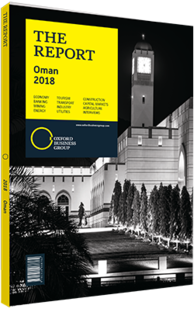Changes ahead: Telecoms
The telecoms market experienced a continued rise in revenue and investments in 2016, with growth rates of approximately 5.6% and 30.9%, respectively.
Total mobile subscribers increased to 6.86m with a growth of roughly 3.3%. Ooredoo saw an uptick of 3.9% in mobile and fixed customers, while Omantel recorded a growth of 7.4% in subscribers.
Analysis Of Business
Omantel’s share price declined in the third quarter of 2017 to its lowest level in three years. However, the news regarding the acquisition of a 21.9% stake in Zain Group, a leading mobile operator in eight MENA countries, and nomination of four new board members had a positive impact on the share price. The acquisition was coordinated to diversify Omantel’s revenue stream away from a single country and to expand internationally. Omantel’s revenue increased by 3%, supported by growth in fixed and mobile broadband. It maintains a market share of 58.9% in the mobile segment and 77.2% in fixed telephone, continuing to dominate the market.
Ooredoo’s share price declined to OR0.526 ($1.37) at the end of 2017 from OR0.66 ($1.71) a year earlier. As of mid-January 2018 the share price was yet to reach its three-year-average price of approximately OR0.665 ($1.73). Ooredoo managed to grow its customer base by 4% in the first nine months of 2017. In the third quarter of 2017 its revenue rose by 1.2%, supported by the increase of mobile and fixed-data products sales. The company improved its network by upgrading its 4G coverage from 55% to 90% of the population.
Revenue in the first nine months of 2017 was up slightly for both Omantel and Ooredoo compared with their performance in the same period in 2016. This was offset by an increase in expenses, which led to reduction in net profits. Royalties, which are paid annually to the government based on a percentage of the licensee’s gross revenue, were raised to 12% in 2017 from 7% previously. The corporate tax rate also increased from 12% to 15%, affecting the net profitability of companies.
Third Licence
Recently, a third licence was offered in a bidding process that was later scrapped in favour of a local consortium. The local company is said to be backed by the government’s wealth fund and a strategic partner. A new operator will contribute to the sector by increasing competitiveness, which will drive the current operators to provide better services, prices and offers.
New Act
The Telecommunications Regulatory Authority (TRA) is drafting a new telecoms act that is expected to cope with the technological revolution and market dynamics of the telecommunications sector globally. Recent regulatory changes appear to be supporting sector growth and competitiveness in the local market for the main telecoms companies as well as for customers. Also, with the new royalty and corporate tax rates, companies will have to adjust in order to improve their financial position. In addition, the TRA has been implementing access and interconnection regulations aimed at easing the entry barriers to the market with the objective of improving market competition. A third mobile network operator will enhance competitiveness in favour of customers and at the expense of the existing operators which have to accommodate to the new rates that notched up their expenses.
Moreover, the country’s existing operators are experiencing strong pressure in the traditional telecoms market from over-the-top (OTT) companies, which raises the questions of when and how will they adapt to these technological advances. One way to compete with this pressure is to focus on the thriving business division of fixed broadband services that the OTT players rely on. The TRA recorded a 54.77% penetration rate as of the second quarter of 2017, as the number of subscribers increased from 52,630 to 314,921.
Another underlying issue faced by every sector of the economy is the overall decrease in spending behaviour caused by lower international oil prices and the economic environment. As such, investment and growth opportunities are likely to decrease in the short term.
You have reached the limit of premium articles you can view for free.
Choose from the options below to purchase print or digital editions of our Reports. You can also purchase a website subscription giving you unlimited access to all of our Reports online for 12 months.
If you have already purchased this Report or have a website subscription, please login to continue.

